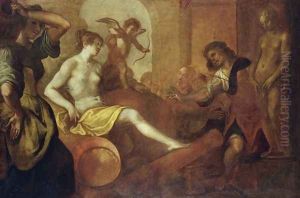Mattaeus Gundelach Paintings
Mattaeus Gundelach, born in 1566 in the Holy Roman Empire, was a notable figure in the realm of glass painting and engraving during the late Renaissance and early Baroque periods. His work, primarily executed in the 16th and 17th centuries, showcases the intricate artistry and technical skill associated with this era's craftsmen. Gundelach’s contributions to art were significant during a time when glass art was evolving from purely decorative and functional items to more expressive artistic pieces.
Gundelach's early life is somewhat obscured by the lack of detailed records, but it is known that he was active in regions that are now part of Germany. He was apprenticed to learn the craft of glass painting, a popular art form that involved the application of colored pigments on glass surfaces, which were then fired to fuse the paint with the glass. This technique allowed for the creation of vibrant, lasting colors that could be assembled into intricate designs, often seen in the windows of churches and cathedrals.
Throughout his career, Gundelach's work was characterized by a remarkable attention to detail and a mastery of the techniques of glass painting and engraving. He was particularly adept at using light and color to create depth and dimensionality in his pieces, skills that were crucial for the dramatic effect sought in religious and secular buildings alike. His engravings on glass were also notable for their precision and beauty, blending artistic skill with technical prowess.
Gundelach's legacy is reflected in the pieces that have survived to the present day, which continue to be studied and admired for their craftsmanship and artistic quality. His contributions to the field of glass art have been recognized in various historical texts and by contemporary art historians who view his work as an important link in the evolution of glass art from functional craftsmanship to a recognized form of fine art.
Despite the challenges of the time, including religious upheaval and the Thirty Years' War, which affected much of Central Europe, Gundelach's work remained in demand. His ability to adapt to the changing tastes and techniques of his era ensured that his artistry would be remembered. He died in 1653, leaving behind a body of work that continues to influence and inspire artists in the realm of glass painting and engraving.
